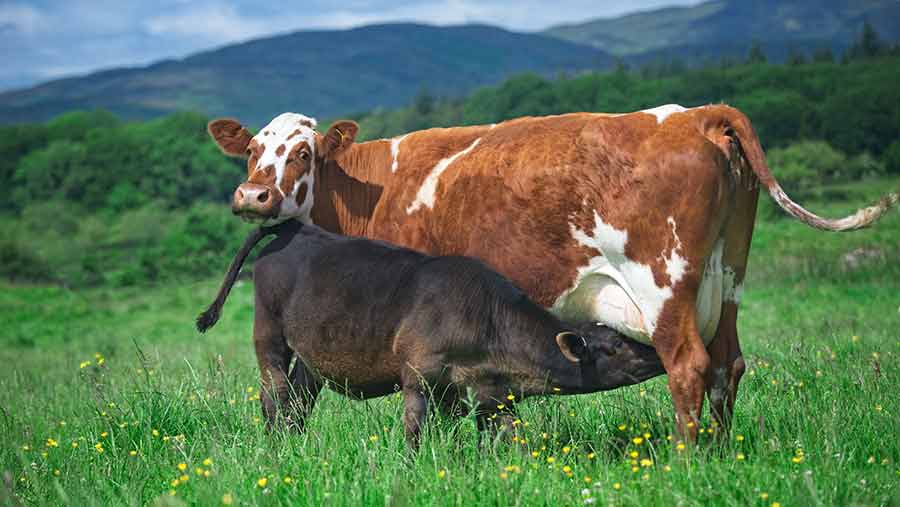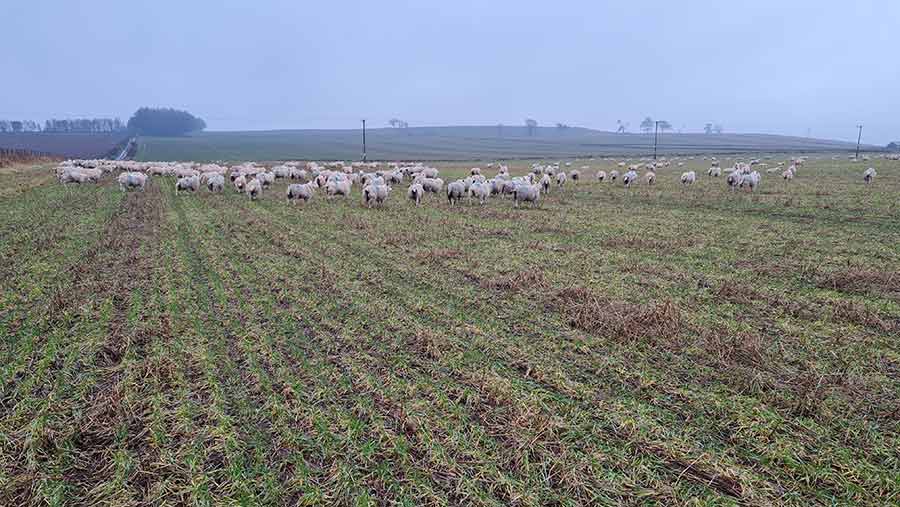4 successful livestock collaborations to learn from
 Calf suckling from its mum at Rainton Farm © Ian Findlay
Calf suckling from its mum at Rainton Farm © Ian Findlay A secure supply of livestock, improved liveweight gain in lambs and benefits to soil health are among the rewards of collaboration for five farmers in Scotland and Northumberland.
Here, they share how and why they work together and what is most important for a successful and mutually beneficial relationship.
See also: £40 a lamb profit forecast from arable farm spin-off
Organic, pasture-fed meat
Collaboration is helping Denise Walton, who farms in partnership with her husband, Chris, and son, Angus, at Peelham Farm, Foulden, Berwickshire, meet a growing demand for organic, pasture-fed meat.
Farm facts: Peelham Farm
- 271ha (669 acres)
- Certified organic and pasture-fed
- 150-head Aberdeen Angus sucklers
- Flying flocks of cull ewes for mutton
- On-farm butchery and direct sales of all meat produced
Initially, they used all their own livestock, with 600 Lleyn ewes and 60 Tamworth cross Red Duroc sows, as well as cattle, to supply the farm butchery the family had established in 2008.
“Our vision was to be a closed-loop, efficient system, growing our own crops to feed our livestock, selling direct and adding value,” says Denise, who started farming with Chris 30 years ago.
As demand grew, however, the farm struggled to produce enough. “We needed more livestock, so we started collaborating with other organic – and subsequently, Pasture-for-Life – producers in Northumberland and south Scotland,” she says.
Now, Peelham Farm focuses on beef, running an Aberdeen Angus suckler herd and finishing cattle at 500kg at 18 months off grass.
Sheep, pigs and dairy-cross calves are sourced from other producers to supply mutton, pork and rose veal through the farm butchery.
Growing demand
“We’re growing our market, and collaboration is a very important part of that, as unless you have 1,000 acres with room for all the species you need, and a large butchery, it’s very difficult.
“The farmers we work with are people we know; they are part of our community and share our ethos and commitment to quality. This is a supporting foundation for collaboration.”
“Mutton flocks” of cull ewes are brought in to graze from late summer.
“We might be looking at 100 at a time for the first and second purchases, then as and when, until April next year. We put them out to graze and draw from them on a weekly basis.”
The Waltons also collaborate with the Ethical Dairy at Rainton Farm, Castle Douglas, which runs a cow-with-calf setup to meet a demand for veal developed in the past 20 years.
Calves are collected from the farm, taken to the abattoir and the carcasses are brought back to the butchery at Peelham.
A new collaboration will see cull sows – the best pigs for making charcuterie, says Denise – from the Organic Pig Company in Norfolk slaughtered at an abattoir close to the farm and carcasses delivered to the butchery at Peelham Farm.
Top tips
- Invest time into developing a good, open relationship, and keeping in touch
- The best relationships are where there is an understanding of each other’s system
Calf collaboration
For David Finlay, who farms with his wife, Wilma, at Rainton Farm, Castle Douglas, working with Denise Walton is a way to help build the market for organic, pasture-fed produce.
He supplies six dairy-beef calves to Peelham Farm every six weeks or so from his herd of 125 cross-bred dairy cows.
Farm facts: The Ethical Dairy, Rainton Farm, Castle Douglas
- 202ha (499 acres) permanent pasture, plus rough grazing, scrub and woodland
- Certified organic and pasture-fed
- 125 cross-bred cows run as a cow-with-calf dairy
- Spring and autumn calving blocks
- Produce ice cream and cheese
- Remaining milk supplied to Omsco
“I say calves – they are actually eight to nine months old and weigh 350-400kg,” he explains.
“They are weaned from their mothers at five months, and then graze or are housed on silage, depending on the season, until they are collected.
“[This collaboration is] about growing the market we’re part of and getting our product to those customers who value it. If they can’t get hold of it, they lose interest and move on.
“When you’re in a fairly remote part of the country and you’re small scale, it can be very difficult to get a beef product to the customer.”
Calves not supplied to Denise are finished on farm at 18-24 months. David admits it would be more profitable to finish all his cattle on farm and sell locally at market, but “the message would then be lost”.
Until spring this year, he was collaborating with a butcher in Twickenham.
“You’d think here of all places, price would not be an issue, but his customers are now going to Aldi or Lidl. The problem is that food is not a high priority.”
For now, David is having to sell locally without an organic premium, while he looks for other routes to market. Lack of access to abattoirs is also a challenge, he says.
Top tip
- If collaboration will help people to know your story and feel they are on your journey with you, go for it, as this is what will engender loyalty
Cull ewe collaboration
Collaborating with Denise Walton brings several advantages to Northumberland beef and sheep farmer Duncan Nelless, who supplies cull ewes to Peelham Farm.
Farm facts: Thistleyhaugh, Near Rothbury, Northumberland
- 800ha (1,976 acres)
- 2,000 Lleyn ewes and 700 ewe lambs
- Finished lambs supplied to Pilgrim’s UK for Waitrose
- 260 Angus-cross and Black Baldy suckler cows and followers
- All progeny retained for breeding or sold
- Certified organic and pasture-fed
The pair got to know each other several years ago when Duncan, who farms with his brother, Angus, at Thistleyhaugh Farm, near Rothbury, Northumberland, was producing organic, free-range poultry and would supply Peelham Farm.
He has been supplying cull ewes for the past 10 years to meet a demand for mutton developed by Denise.
“The benefits for us are there’s no commission to pay, saving me £3 a head, and no transport, as Denise collects the ewes.
“Also, the ewes can go before they are “market ready”, which is a real advantage as I don’t have the resources to do that here, so it frees up space for us to focus on the stock we do want to keep.
“It’s an imaginative use for the mutton too, using it for charcuterie.”
Duncan also likes the fact the ewes are being supplied for an organic market, which would not be the case if he sold them at market.
He and Denise work off the market average to agree a price for each batch of ewes. Last year, Duncan selected about 380 cull ewes from his flock of 2,000 Lleyns, and Denise had about 150 of them.
Duncan also collaborates with other farmers through grazing agreements.
Top tip
- Collaboration is a “people thing” – you’ve got to get along and trust each other
Sheep-arable collaboration

Sheep grazing winter wheat in mid-March © James Hopkinson
Perthshire sheep farmer Alex Brewster met James Hopkinson, who grows arable crops in neighbouring Angus, a few years ago at Groundswell, the annual regenerative agriculture event.
Living 40 minutes apart, they knew of each other, but moved in different farming circles.
Their conversation led to a successful collaboration, where Alex, tenant at Rotmell Farm in the Tay Valley and contract-farmer for Lude Estates, uses James’s arable land at Walker-Munro Farms to develop hill ewe lambs for breeding stock.
Farm facts
Rotmell Farm, Tay Valley, Perthshire
- 1,000ha (2, 470 acres)
- 750ha (1,853 acres) is effective, made up of 130ha (320 acres) of improved pasture and the rest upland grazing
- 500 Cheviot-cross breeding ewes
- 150 Angus sucklers
- 4,000 free-range laying hens
Lude Estates, Perthshire
- 3,500ha (8,648 acres) of mostly big hill, with 230ha (568 acres) of improved pasture
- 1,200 Cheviot-cross breeding ewes
- 150 White Shorthorn cross Highland sucklers
Walker-Munro Farms, Forfar, Angus
- 700ha (1,730 acres)
- Grows wheat, winter and spring barley, winter and spring oats, spring beans, winter oilseed rape and cover crops
- Varied soils from heavy clays to deep peats and light sands
“Our thinking was aligned at that point,” says Alex. “People were twitchy about grazing cereals, but James sees a lot of benefits in nutrient cycling and soil health and biology.”
Alex selects ewe lambs from Rotmell and Lude (once those to be lambed as yearlings have been selected) to graze winter wheat, winter barley and cover crop mixes grown as soil enhancers.
Last winter, numbers ran to 350; this year, he expects to send 500.
The lambs are managed on three- to four-day moves on 3-4ha (7.5-10-acre) blocks to achieve grazing of 50% of the available dry matter.
Livestock benefits
“Previously, we put lambs away on grasslands elsewhere in the country,” he says.
“The biggest difference here is that they are on better soils and the crops are, in effect, clean grazing with no parasite history.
“And because they are grazing consistent, newly established crops all the time, the liveweight gain and the health of the lambs are phenomenal. They really motor.”
The lambs start grazing the arable land in late October/early November and are back off by late March.
James supplies the land and the crops and receives a weekly per-head fee, while Alex supplies the electric fencing through Powered Pasture and manages and moves the sheep.
Arable benefits
James, who also runs a contracting business, Arable Ventures, aims to reduce the intensity of tillage and the use of pesticides on the farm by grazing sheep.
At harvest, instead of using a conventional combine header, a stripper header is used to leave standing straw.
This acts as “soil armour”, lessening the effect of heavy rainfall events, he says.
Some of the straw is pushed over by the press wheel when the following crop is drilled with a min-till drill, creating a “mat” for the crop to grow through.
The two farmers understand what is important for each other: “The fields don’t get muddy, even if it’s wet, so the sheep’s feet are protected,” says James.
Alex explains the mat protects the soil from damage because they are walking on a “carpet”, and the new crop from overgrazing.
“Because of the sheep, I have more confidence to drill earlier,” adds James.
“This increases the risk of disease in the crop, but it also gives the crop more opportunity to tiller and put down roots.
Because the sheep graze the foliage down, I definitely think they reduce that risk.”
Alex Brewster and James Hopkinson’s top tips
- Make sure you are on the same wavelength and trust each other
- Be clear about what you are trying to achieve
- The weather is the third party in the collaboration, so do your best with the hand you are dealt in any given season
